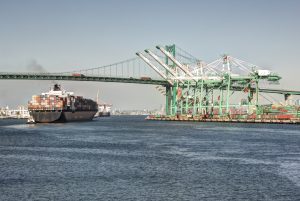Remember the backlog of containers waiting to be unloaded at the United States’ Los Angeles and Long Beach ports last year? That’s set to happen again due to China’s “zero-tolerance” COVID policy, which has massively slowed down Shanghai port’s container unloading as well as domestic production for exports. Once the lockdown is lifted and economic activity once again springs to life, a pileup of products from accumulated orders will surge into the United States.
Already, supply chain managers are experiencing shortages in goods sourced from China, particularly in the electronics, automotive, and semiconductor sectors. The United States imports close to 20 percent of all products and 35 percent of electronics from China. The European Union Chamber of Commerce in China sent a letter to Chinese officials asking them to rethink the zero-tolerance COVID-19 policy due to severe disruptions to European supply chains. Ocean shipping delays to major European cities had more than doubled even before the Shanghai lockdown began.
Hundreds of container ships and bulk ships are waiting to unload off the port of Shanghai, while air carriers have announced numerous cancellations. Trucking activity in China has slowed, as truckers face the possibility of quarantine or being blocked off on the road. Truckers and workers have also been subjected to mass COVID-19 testing. Now, there are not enough truckers to bring finished goods to ports or to bring raw materials to factories.
Empty containers are waiting for truckers to bring them to inland manufacturers to be filled and sent back out for export or domestic sale. In some places where factories remain open, workers are sleeping on site and producing goods, many of which are being stored in warehouses until normal trucking schedules resume. On the other side of the world, the U.S. is experiencing a glut of empty containers, resulting in a decline in some container prices.
This will soon change. A surge in imports into the United States from China is expected to take place in June or July, creating congestion once again for Southern California ports, which last experienced peak congestion in January. Long Beach and the Port of Los Angeles import about 40 percent of all containerized goods into the U.S. The surge is likely to overwhelm West Coast ports, which have finally returned to normal throughput.
What is more, warehouses are currently at capacity and connecting railways are finding themselves backed up already due to lack of equipment. Labor negotiations between West Coast dockworkers and ocean carriers and port operators may further pinch Western ports.
Close to the Christmas season last year, marine terminals found themselves operating at more than full capacity. This was due to a surge in demand as well as supply. At present, although many retailers have restored their inventory to normal levels, there is the fear that a shortage of components or finished goods will impact both retailers and producers in the United States in a matter of weeks. Importers have faced numerous shocks in recent years, created by the China-U.S. trade war, COVID-19, and now the Russia-Ukraine war.
Furthermore, another surge in port activity is likely to trigger ongoing shortages in trucking capacity due to a lack of truck drivers. Although the United States has struggled with this issue for some time, the shortage of truck drivers has entered a crisis stage. It is estimated that the U.S. is short about 80,000 drivers.
In order to prevent this disruption from interrupting their supply chains, some firms are looking to move supply chains out of China. FreightWaves has noted a large increase in freight modeling requests for companies that are looking to relocate production. Alternative sourcing locations in Asia include Vietnam and Malaysia. In the short term at least, many U.S. importers will simply have to endure yet another disruption in global supply chains.

































